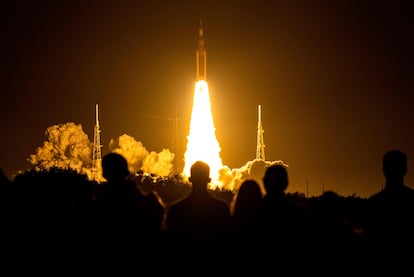Why do we want to go back to the moon?
This year, several lunar exploration missions were launched from Earth, and NASA will launch the first crewed flight of the Artemis program in 2024. But... What are they looking for?

In July of 2023, the Indian Space Research Organization (ISRO) launched the Chandrayaan-3 mission, the third in the Chandrayaan program, which is a series of lunar exploration missions. The spacecraft entered lunar orbit on August 5, and the lander touched down near the lunar south pole on August 23, becoming the first craft to do so ever.
A few weeks later, Roscosmos, the Russian Space Corporation, launched a similar mission. Named Luna 25, it was the first lunar lander they had sent to the Moon and would have been their first lander to touch down on the lunar south pole. However, on August 19, the lander crashed on the Moon’s surface after a failed orbital maneuver.
Since 2022, NASA, along with its major partner agencies, the European Space Agency, the German Aerospace Center, the Japan Aerospace Exploration Agency, the Canadian Space Agency, the Israel Space Agency, and the Italian Space Agency, has initiated the Artemis Program. Its goal is to reestablish a human presence on the Moon for the first time since the Apollo 17 mission in 1972. Its first flight, Artemis 1, departed on November 16, 2022, carrying the Orion spacecraft, which deployed several satellites before returning and reentering Earth’s atmosphere on December 11, 2022. Following this, the agency is preparing to launch Artemis 2, its first crewed flight, which will perform a flyby of the Moon before returning to Earth in 2024. In that same year, NASA will deliver a lunar rover, tasked with prospecting for lunar resources in shadowed areas in the lunar south pole region and mapping the distribution and concentration of water ice.
These missions seem to be part of a new era in lunar exploration. But why do experts want to reexamine the Moon? Here’s the answer.
Looking for water on the Moon
The missions we mentioned are focused on one crucial location: the lunar south pole, an area that has not been explored in the past. By surveying this region, experts can gain a better understanding of the elements found on the Moon and what its surface reveals about Earth.
Dr. Becky Smethurst, an astrophysicist at the University of Oxford, told the BBC, “Our leading theory for how the Moon formed is that another planet collided with the very early Earth 4 billion years ago. This collision vaporized that planet and a significant part of the Earth as well, leaving behind the debris that formed the Moon. The Moon is an ideal place to study how the Earth formed. Unlike Earth, it lacks an atmosphere, plate tectonics, and any of the fossil record, as all of it has been erased. On the Moon, we have this pristine, inner rock where every single event in its 4.5 billion years of history is recorded.”
The expert highlights that the “dark side of the Moon” has a complex surface that can reveal a lot about the Moon’s past and history: “The side of the Moon we can’t see from Earth is incredibly pockmarked with craters. This is significant when considering what happened to the early Earth because we believe that all of Earth’s water came from impacts with comets and asteroids in the very early days of the Solar System. We know that comets contain ice and water, so we think comets delivered water to Earth. Unfortunately, we have no record of those impacts on Earth, but they are recorded on the Moon. The south pole is an excellent place to look for evidence of these impacts.”
But why go to the south pole and these dark areas? Dr. Smethurst explains that the missions are going there because that area of the Moon is heavily cratered, and experts want to find out what’s inside these craters and how they appear. “You’ve got deep craters where sunlight likely has never reached the bottom. These craters were probably formed by comets colliding with the Moon in the early days of the solar system, leaving their water in the form of ice. It’s likely that this ice is still there in the same form as it was 4 billion years ago, making it a perfect record of those early events.”
If they do find water, “they’ll be examining whether its composition is similar to water on Earth.” This is crucial for space agencies because if there’s water on the Moon with a composition similar to Earth’s, it can be used to establish a base on the Moon and create rocket fuel, which would be essential for launching astronauts to other destinations like Mars.
Chandrayaan-3

ISRO’s Chandrayaan-3 mission aims to achieve several key objectives. First, it involves the development and deployment of a specialized lander designed to make a safe and gentle touchdown on the lunar surface. Second, the mission will showcase the rover’s mobility and exploration capabilities on the Moon, helping validate the practicality of lunar surface operations. Lastly, Chandrayaan-3 will conduct various experiments focused on analyzing the materials found on the lunar surface, contributing to a deeper understanding of the Moon’s composition and its potential resources. These objectives collectively represent a significant step forward in India’s lunar exploration efforts and will provide valuable data to the scientific community.
Artemis’ VIPER
VIPER (Volatiles Investigating Polar Exploration Rover) is scheduled for lunar surface deployment in November 2024 as part of NASA’s Artemis Program. This cutting-edge rover’s primary mission is to survey potential lunar resources within the permanently shadowed terrains of the Moon’s south pole. Its main focus revolves around mapping the distribution and concentration of water ice in this region.
Sign up for our weekly newsletter to get more English-language news coverage from EL PAÍS USA Edition
Tu suscripción se está usando en otro dispositivo
¿Quieres añadir otro usuario a tu suscripción?
Si continúas leyendo en este dispositivo, no se podrá leer en el otro.
FlechaTu suscripción se está usando en otro dispositivo y solo puedes acceder a EL PAÍS desde un dispositivo a la vez.
Si quieres compartir tu cuenta, cambia tu suscripción a la modalidad Premium, así podrás añadir otro usuario. Cada uno accederá con su propia cuenta de email, lo que os permitirá personalizar vuestra experiencia en EL PAÍS.
¿Tienes una suscripción de empresa? Accede aquí para contratar más cuentas.
En el caso de no saber quién está usando tu cuenta, te recomendamos cambiar tu contraseña aquí.
Si decides continuar compartiendo tu cuenta, este mensaje se mostrará en tu dispositivo y en el de la otra persona que está usando tu cuenta de forma indefinida, afectando a tu experiencia de lectura. Puedes consultar aquí los términos y condiciones de la suscripción digital.









































